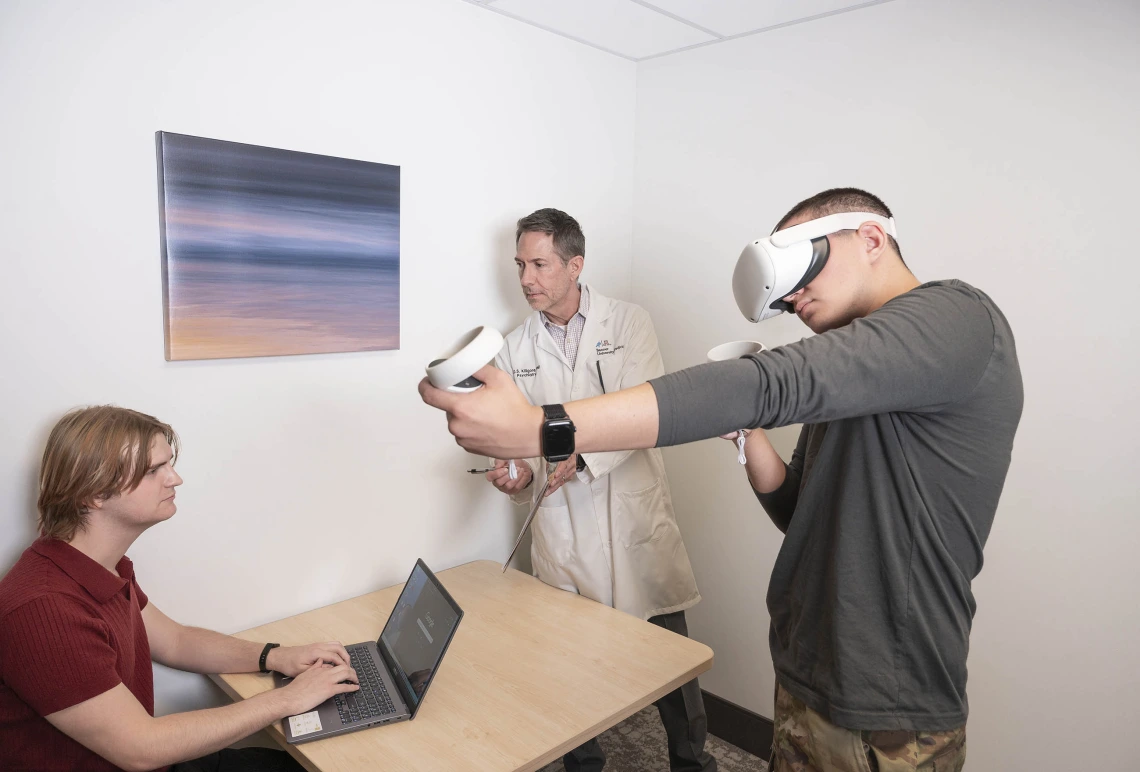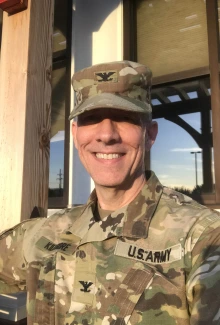Applying VR and AI to find a faster way to test for TBI
University of Arizona Health Sciences researchers are developing a portable tool to diagnose military personnel on the battlefield.

University of Arizona Health Sciences researchers are developing the Virtual Reality Military Operational Neuropsychological Assessment, or VRMONA, which will combine virtual reality and artificial intelligence to identify traumatic brain injury.
A roadside bomb goes off, sending soundwaves rippling through the air and into the soft tissue of a soldier’s body. The blast continues up, popping microscopic blood vessels in the brain. The service member is dazed, but regains their footing and presses forward, thinking they narrowly avoided a serious wound.
This is just one example of how someone in the military might sustain a traumatic brain injury, or TBI. TBI can be caused by a blow to the head or anything that causes a jolt to the brain. It is one of the most common forms of injury in recent military conflicts.
Moderate and severe TBIs can be fatal or lead to lifelong health problems. Fortunately, most traumatic brain injuries are mild. But even a mild TBI, also referred to as a concussion, can have ongoing complications and need time to heal.

William D.S. Killgore, PhD, is a clinical neuropsychologist and research neuroscientist whose research focuses on understanding the brain systems involved in emotional processes and cognitive performance.
“A mild TBI can cause portions of the outer layer of the brain, the cerebral cortex, to shift or slide. This tears the nerves connected to it. These damaged connections often repair themselves, but sometimes they shrivel up and die,” said William D.S. Killgore, PhD, a professor and the director of the Social, Cognitive and Affective Neuroscience Lab in the College of Medicine – Tucson’s Department of Psychiatry. “A person with this injury could have trouble concentrating or remembering information, experience dizziness, fatigue, or disturbed sleep, and they might have trouble regulating their emotions.”
Killgore and his team are developing a small, portable tool to quickly diagnose military personnel with TBI in the field. The Virtual Reality Military Operational Neuropsychological Assessment, or VRMONA, will use virtual reality and artificial intelligence to identify brain deficits through a combat-type “game.”
A new tool for the medic bag
The gold standard for assessing a traumatic brain injury is a neuropsychological assessment usually consisting of a battery of paper-and-pencil tests administered by a highly trained psychologist. This can take as long as four to eight hours. For small teams conducting military operations in far flung areas, this approach is usually not feasible.
“The traditional style of assessment can be taxing on a person. You want to measure multiple domains, like memory, language and spatial skills. On paper, that involves a separate test for each,” said Killgore, who is a member of the university’s BIO5 Institute. “If successful, our computer systems may find where these domains overlap on different tasks in the game and distill the whole process down to 10 or 20 minutes. VRMONA could be a revolutionary new way to assess traumatic brain injury.”

Killgore and his team will use traditional neurological exams and VRMONA to assess four neurocognitive domains that are particularly sensitive to the effects of mild traumatic brain injury: attention, processing speed, memory and executive function.
Killgore’s team has already developed a prototype for VRMONA that is made up of a VR headset and handheld controllers paired with an AI technique known as deep neural network learning. Their new research, funded by a $1.5 million Department of Defense grant, will upgrade the equipment and the game itself while evaluating 1,000 participants over several phases of development.
In the first phase, participants will be split into three groups: a healthy control group; people with mild-to-moderate TBI; and those with other neurological disorders. Data will be collected from traditional neurological exams and cross-referenced with data and results from VRMONA. Researchers will update and revise the system over three cycles of testing.
“Some people might not see the value in something like an abstract puzzle test; I think soldiers will relate to something that resembles their job,” Killgore said. “The great part about VRMONA is that it connects the service member to tasks relevant to their day-to-day lives. The simulation might require the person to pay attention to what is going out over their radio, quickly sight a weapon, or make a decision to shoot or not shoot. It will look similar to video games they might have already played, and I think they will want to beat the game.”

The UArizona Health Sciences SensorLab provided the equipment and seed funding to help develop a VRMONA prototype.
If successful, VRMONA will be able to instantly collect and analyze data allowing it to identify deficits associated with TBI in a fraction of the time of a traditional assessment. Killgore hopes future iterations and advancements of VRMONA will be scaled down in size so that the equipment can fit into a medic’s bag and be operated by nonmedical personnel, if needed.
“Eventually, we also want to increase the diagnostic abilities to precisely identify what type of neurological disorder someone is suffering from. This could be anything from adult attention deficit disorder to Parkinson’s or Alzheimer’s disease,” Killgore said. “I think we will be able to adapt VRMONA for people outside of the military as well. Instead of a combat-style game, it could be a simulation where you need to drive to the store for groceries or prepare a dinner.”
The path that led to VRMONA
Killgore said the project would not have been possible without a seed grant from the University of Arizona Health Sciences SensorLab. It was in the SensorLab that his team developed the prototype for VRMONA and demonstrated a proof of concept.
“We started awarding seed grants in 2021 and so far, we have helped fund 23 projects. One of the main objectives of these grants is to allow researchers to get pilot data, test their concepts and apply for larger external grants,” said Gustavo de Oliveira Almeida, PhD, SensorLab coordinator and a member of the BIO5 Institute. “Along with funding we also provide our space, equipment and technical support.”
SensorLab resources include state of the art devices and wearable sensors that can track variables like heart rate and eye motion. Collaborations have ranged from research into tai chi to robotic surgery.

For the past decade, Killgore, an Army veteran, has focused much of his work around factors affecting the mental health, well-being and performance of military personnel.
Through the SensorLab, Dr. Killgore’s team was able to launch their project and collect pilot data with a commercially available VR system and a simple shoot-no-shoot game. They brought in 20 healthy individuals to play the game and compared results to traditional neurological assessments.
“The SensorLab is a versatile and flexible space that can offer varying levels of collaboration, technology and equipment based on the needs of the teams we work with,” said Almeida. “It was fascinating to work with Killgore and his team, and we look forward to their future findings.”
Killgore has focused much of his research on the mental health and well-being of those in the armed forces. His work in this area dates to his own military service, which began after Sept. 11, 2001.
“When the planes hit the Twin Towers, I decided to join the Army as a researcher. I left Harvard, where I was already starting my research career, and joined the military. My friends couldn’t believe it,” said Killgore, who became a research scientist in the Sleep Research Center at the Walter Reed Army Institute of Research in Silver Spring, Maryland.
“I spent five years on active duty doing research on sleep, post-traumatic stress disorder and other issues,” he said. “I went back to academic research after that, but I stayed in the Army Reserves. In total, I’ve spent 22 years in the military.”
Killgore said the symptoms of a mild concussion can easily be overlooked on a chaotic battlefield. VRMONA could help teams quickly assess an injured soldier so they can make the best decision that person’s health and for their mission.
“Veterans often call mild TBI an invisible wound of war,” Killgore said. “Soldiers may look OK on the outside, but every area of their life may be impacted. VRMONA may help reduce the risk of continued injury and allow someone the opportunity they need to rest and heal.”
Our Experts
William D.S. Killgore, PhD
Professor, Psychiatry, College of Medicine – Tucson
Professor, Medical Imaging, College of Medicine – Tucson
Professor, Psychology, College of Medicine – Tucson
Member, BIO5 Institute
Gustavo de Oliveira Almeida, PhD
Coordinator, SensorLab
Member, BIO5 Institute
Contact
Brian Brennan
University of Arizona Health Sciences Office of Communications
520-621-3510, brianbrennan@arizona.edu

